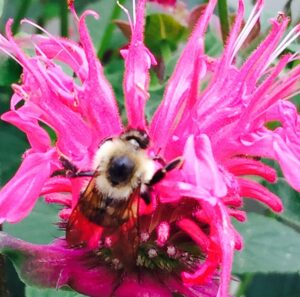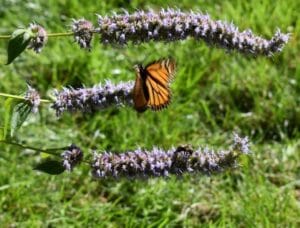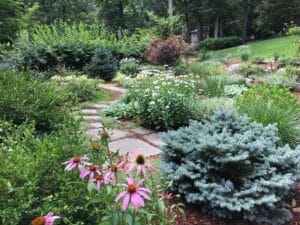Hello fellow readers, I recently received an email from the NJ Landscape Contractors Association (NJLCA), alerting members about legislation pending to limit the use of neonicotinoid insecticides to agricultural properties only. Neonicotinoids (neo·nic·o·ti·noid) are a synthetic derivative of nicotine.
Shell first developed them in the 1980s and Bayer in the 1990s. Per Wikipedia, “Neonicotinoid use has been linked in a range of studies to adverse ecological effects, including honey-bee colony collapse disorder (CCD) and loss of birds due to a reduction in insect populations.”
 The concern for pollinators dates back many years.
The concern for pollinators dates back many years.
The email encouraged members to participate in a virtual hearing about Bill S1016 with the Assembly Environment & Solid Waste Committee to testify why they shouldn’t ban products based on the fiscal impact to the landscape industry. There was a link to sign up, offering prompts for their testimony. Maybe the prompts were a way to ease members’ hesitation to participate, but it seems odd to lead a testimony.
Saving America’s Pollinator Act has died 3 times.
There’s also national legislation underway called Saving America’s Pollinator Act (HR 1337: 2019) to suspend the use of “clothianidin, thiamethoxam, dinotefuran, and any other members of the nitro group of neonicotinoid insecticides” until there is a determination “that such insecticide will not cause unreasonable adverse effects on pollinators.” Sadly, the bill hasn’t gotten far. And former versions of the bill (I tracked three since 2013) died in Congress previously.
 Neonicotinoids are banned in other countries.
Neonicotinoids are banned in other countries.
In 2018 the European Union banned the three most widely used neonicotinoids (clothianidin, imidacloprid, and thiamethoxam) for all outdoor uses. And several states in the US have restricted their usage.
My dear Curt mentioned Frank von Hippel, who recently published The Chemical Age: How Chemists Fought Famine and Disease, Killed Millions and Changed Our Relationship with the Earth (9/4/20 University of Chicago Press). He was interviewed on the Joe Rogan Experience Podcast. As an ecotoxicology professor at Northern Arizona University, Frank taught ecology field courses in over twenty countries and conducted research in Africa, Australia, and the Americas.
The development of chemicals came with good intentions.
It took von Hippel nine years to author the book, which includes a fascinating worldwide history of pandemics, chemical use, and its ecological implications. The history of the development of chemicals came with good intentions—to end famine and prevent disease. Sadly, long-term effects were often not considered. It’s alarming to learn how pesticides not used in remote parts of the world, such as Antarctica, find their way there in alarming concentrations.
An alternative to chemicals = Integrated Pest Management (IPM)
Joe Rogan asked what the alternatives to chemical use are, and von Hippel described Integrated Pest Management (IPM). IPM is an environmentally responsible way to maximize food production while managing pests and diseases. It’s a combination of primarily biological controls (such as predatory insects, nematodes, and animals) and limited use of chemicals. With IPM, “you use the least amount and the least toxic pesticide and only where it’s necessary,” Frank von Hippel said.
While having great respect for their initiatives, a troubling part of the email from the NJLCA was a declaration: “Unfortunately, this measure (to ban Neonicotinoids other than agricultural use) is driven by raw emotion, inaccurate media hype, and completely overlooks the complexity of the bee health issue as well as the fact that no scientific evidence exists to show that the lawful use of neonicotinoids systematically threatens bees and other pollinators.” That’s a big claim.
It’s a balancing act to strive to live better and preserve the environment.
Indeed, it’s a complicated subject. No doubt, the world is comprised of chemicals, and it’s a balancing act to strive to live better and preserve the environment. You can go down the rabbit hole researching scientific reports and studies, maneuvering through interpretations not always based on fact. But it seems logical that adding manufactured chemicals to our world must impact nature’s balance of things.
We can all make a difference in our community by planting gardens to attract pollinators using mainly native species and non-GMO seeds free of neonicotinoids. Most of all, Bee kind to our dear earth, and Bee thankful for the world in which we live. Garden Dilemmas? AskMaryStone@gmail.com (and now on your favorite Podcast App.)
Link to a previous column about a garden for pollinators– A Buttlerfly Garden of Growth
and Stephanie’s Front Yard Alternative
More about Integrated Pest Management




Hello Mary,
Thank you for the Neonicotinoid Insecticide information.
On another topic, at the beginning of the summer, I got some seedlings from the Hope Environmental Commission which they usually give out at their Green Fair, but even though there was no Green Fair this year, they gave them out anyway. I planted five and four are thriving having survived the summer: a hickory, a dogwood, a redbud, and a bur oak. Cold temperatures are beginning to descend upon us. Should I wrap the. trees in something? How do I keep them safe through the winter and freezing temps? Thank you so much!
Hi Sarah, How exciting to have four bouncing baby trees! I’d say once they are dormant, a tomato cage wrapped around with burlap wouldn’t be a bad idea to protect them from drying winter winds and deer browse. Thank you for reading my column :^), Mary